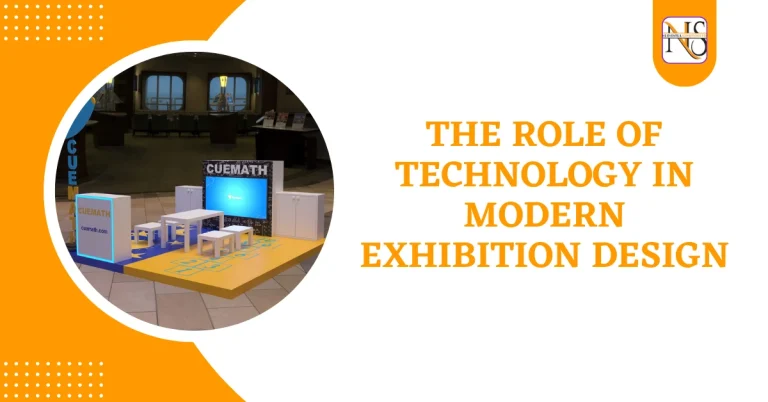The Impact of Technology on Modern Exhibition Stand Design: Elevating Visitor Engagement and Experience
In today’s fast-paced, technology-driven world, businesses are constantly seeking innovative ways to stand out, especially in competitive environments like exhibitions and trade shows. Gone are the days when a simple banner and product display sufficed. Modern exhibition stands are now dynamic, interactive spaces that captivate visitors through the integration of cutting-edge technology. From digital displays and AR/VR experiences to interactive touchpoints, technology has revolutionized exhibition stand building, making it possible to create unique, engaging experiences that leave lasting impressions.
This blog explores how technology is shaping the future of expo stand design, how exhibitors can enhance visitor engagement, and why forward-thinking businesses need to embrace these trends to remain competitive.
1. Digital Displays: Capturing Attention from the First Moment
The first impression is critical in exhibitions, and digital exhibition displays offer a visually compelling way to capture attention and convey a brand’s message. Whether through high-resolution LED screens, interactive kiosks, or even 3D holographic displays, exhibitors can create immersive storytelling experiences that go beyond static graphics.
For example, exhibition builders can incorporate dynamic presentations that change based on visitor interaction, showing off products in use, highlighting key benefits, or showcasing customer testimonials. These digital experiences not only draw attendees in but also encourage deeper engagement, keeping the brand message fresh and relevant throughout the exhibition.
2. Augmented Reality (AR) and Virtual Reality (VR): Transporting Visitors into a New Dimension
Augmented Reality (AR) and Virtual Reality (VR) are no longer reserved for tech giants or gaming companies. These immersive technologies have made their way into exhibition displays, transforming the way businesses showcase their products and services. AR can overlay digital information onto real-world objects, allowing visitors to visualize complex products or explore features in real-time.
On the other hand, VR can transport visitors to entirely new environments. For instance, an exhibitor in the automotive industry can use VR to give attendees a virtual tour of a car’s interior or simulate a test drive, all from the exhibition floor. The combination of AR/VR makes it easier for businesses to convey detailed, technical information in an exciting, interactive way, leaving visitors with a memorable experience.
3. Interactive Touchpoints: Turning Passive Visitors into Active Participants
Interactive touchpoints are a cornerstone of modern exhibition stands, transforming passive observers into active participants. These can range from touchscreens and gesture-based interactions to more sophisticated sensors and smart devices that respond to visitor behavior.
For example, a smart exhibition stand might feature touch-enabled displays that allow visitors to browse product catalogs, watch videos, or even customize products on the spot. This not only encourages more time spent at the stand but also provides exhibitors with valuable data about visitor preferences and behavior. Exhibition stand building with interactive elements offers an opportunity for deeper engagement, as visitors are more likely to remember and talk about stands that provided a unique, hands-on experience.
4. Data Collection and Personalization: Enhancing the Post-Event Connection
Technology-driven exhibition stands provide more than just visual appeal—they offer opportunities for data collection and personalization. Tools such as QR codes, RFID badges, or facial recognition software allow exhibitors to gather data on visitor demographics, interests, and behavior. This data can be used for follow-up marketing campaigns, personalized communication, or to improve future exhibition strategies.
Additionally, exhibitors can use this data to offer real-time personalization during the event. Imagine an exhibition stand where the content on digital displays or interactive kiosks changes based on who is standing in front of it. This level of personalization makes visitors feel valued, increases their engagement, and strengthens the overall brand experience.
5. Sustainability Through Technology: Building a Greener Future
An often-overlooked benefit of incorporating technology into exhibition stand design is its positive impact on sustainability. Traditional exhibition stands can generate a significant amount of waste due to printed materials, temporary structures, and excess promotional items. By replacing physical materials with digital solutions, businesses can reduce their environmental footprint.
For instance, replacing printed brochures with interactive digital displays or using AR to showcase product features can significantly cut down on waste while also enhancing the visitor experience. Many exhibition builders are now focusing on creating sustainable, tech-driven stands that are not only visually appealing but also eco-friendly.
6. Leaving a Lasting Impression
The goal of any exhibition stand is to leave a lasting impression, and technology is a key enabler in achieving this. A well-designed exhibition stand with integrated tech elements not only attracts more visitors but also ensures they walk away with a memorable experience. The use of AR/VR, digital displays, and interactive touchpoints creates a dynamic, engaging environment where visitors are not just spectators but active participants in the brand’s story.
In today’s digital age, incorporating these technologies into exhibition stand building is no longer optional—it’s essential. Brands that embrace these innovations will not only stand out on the exhibition floor but will also leave a lasting impact on their target audience long after the event has ended.
Conclusion: The Future of Exhibition Stands
As technology continues to evolve, so too will the possibilities for exhibition stand design. The integration of digital displays, AR/VR, and interactive touchpoints is just the beginning. Future trends may include AI-powered chatbots, more advanced data personalization, and even greater sustainability efforts.
For businesses looking to create impactful exhibition experiences, working with an experienced exhibition builder who understands the role of technology is crucial. By leveraging the latest tech innovations, companies can create stands that not only engage visitors but also deliver long-term value by enhancing brand awareness and driving post-event connections.
In conclusion, the combination of creativity and technology in exhibition displays can transform any exhibition space into a hub of excitement and interaction, leaving a lasting impression on every visitor that walks through the door.




